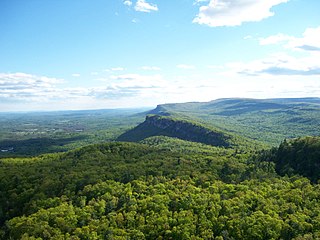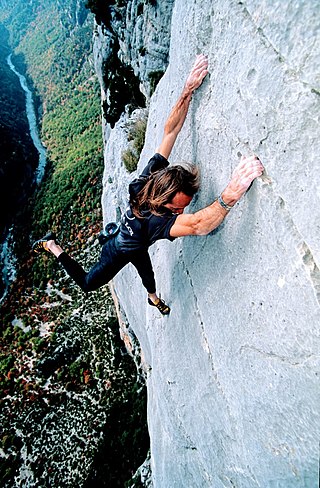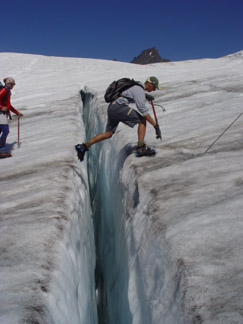Shock
- Anaphylaxis associated with stings
- Hypovolemic shock (due to hemorrhage) associated with climbing falls, kayak crashes, etc.
- Septic shock
The following is a list of symptoms and conditions that signal or constitute a possible wilderness medical emergency.

Mountaineering, mountain climbing, or alpinism is a set of outdoor activities that involves ascending mountains. Mountaineering-related activities include traditional outdoor climbing, skiing, and traversing via ferratas that have become sports in their own right. Indoor climbing, sport climbing, and bouldering are also considered variants of mountaineering by some, but are part of a wide group of mountain sports.

A climbing harness is a device which allows a climber access to the safety of a rope. It is used in rock and ice climbing, abseiling, and lowering; this is in contrast to other activities requiring ropes for access or safety such as industrial rope work, construction, and rescue and recovery, which use safety harnesses instead.

Glossary of climbing terms relates to rock climbing, mountaineering, and to ice climbing.

The Shawangunk Ridge, also known as the Shawangunk Mountains or The Gunks, is a ridge of bedrock in Ulster County, Sullivan County and Orange County in the state of New York, extending from the northernmost point of the border with New Jersey to the Catskills. The Shawangunk Ridge is a continuation of the long, easternmost section of the Appalachian Mountains; the ridge is known as Kittatinny Mountain in New Jersey, and as Blue Mountain as it continues through Pennsylvania. This ridge constitutes the western border of the Great Appalachian Valley.

Free solo climbing, or free soloing, is a form of rock climbing where the climbers climb solo without ropes or other protective equipment, using only their climbing shoes and their climbing chalk. Free soloing is the most dangerous form of climbing, and, unlike bouldering, free soloists climb above safe heights, where a fall can be fatal. Though many climbers have free soloed climbing grades they are very comfortable on, only a tiny group free solo regularly, and at grades closer to the limit of their abilities.

The Bridger Wilderness is located in Bridger-Teton National Forest in Wyoming, United States. Originally established in 1931 as a primitive area, 428,169-acre (1,732.74 km2) region was redesignated as a wilderness in 1964 and expanded to the current size in 1984. The wilderness lies on the west side of the Continental Divide in the Wind River Range and contains Gannett Peak; at 13,809 feet (4,209 m) it is the tallest mountain in Wyoming. The wilderness is a part of the Greater Yellowstone Ecosystem.

A bee sting is the wound and pain caused by the stinger of a female bee puncturing skin. Bee stings differ from insect bites, with the venom of stinging insects having considerable chemical variation. The reaction of a person to a bee sting may vary according to the bee species. While bee stinger venom is slightly acidic and causes only mild pain in most people, allergic reactions may occur in people with allergies to venom components.

Outdoor recreation, such as hiking, camping, canoeing, cycling, or skiing, entails risks, even if participants do not recklessly place themselves in harm's way. In some circumstances, such as being in remote locations or in extreme weather conditions, even a minor accident may create a dangerous situation that requires survival skills. However, with correct precautions, even fairly adventurous outdoor recreation can be enjoyable and safe.

A safety harness is a form of protective equipment designed to safeguard the user from injury or death from falling. The core item of a fall arrest system, the harness is usually fabricated from rope, braided wire cable, or synthetic webbing. It is attached securely to a stationary object directly by a locking device or indirectly via a rope, cable, or webbing and one or more locking devices. Some safety harnesses are used in combination with a shock-absorbing lanyard, which is used to regulate deceleration and thereby prevent a serious G-force injury when the end of the rope is reached.

Looking Glass Falls is a waterfall in Western North Carolina, located near Brevard.

Mount Hood climbing accidents are incidents related to mountain climbing or hiking on Oregon's Mount Hood. As of 2007, about 10,000 people attempt to climb the mountain each year. As of May 2002, more than 130 people are known to have died climbing Mount Hood since records have been kept. One of the worst climbing accidents occurred in 1986, when seven high school students and two teachers froze to death while attempting to retreat from a storm.
The following outline is provided as an overview of and topical guide to emergency medicine:
Mount Febbas is located in the Wind River Range in the U.S. state of Wyoming. Mount Febbas is at the western end of the high-altitude plateau known as Horse Ridge, which extends for more than 10 mi (16 km) to the northeast at elevations greater than 10,000 ft (3,000 m).

Many species of arthropods can bite or sting human beings. These bites and stings generally occur as a defense mechanism or during normal arthropod feeding. While most cases cause self-limited irritation, medically relevant complications include envenomation, allergic reactions, and transmission of vector-borne diseases.
A wilderness medical emergency is a medical emergency that takes place in a wilderness or remote setting affinitive care. Such an emergency can require specialized skills, treatment techniques, and knowledge in order to manage the patient for an extended period of time before and during evacuation.
Poke-O-Moonshine Mountain, spelled Pokamoonshine on U.S. Geological Survey maps, and sometimes known as just Poke-O, is a minor peak of the Adirondack Mountains. The name is believed to be a corruption of the Algonquin words pohqui, meaning 'broken', and moosie, meaning 'smooth'. It is located in the town of Chesterfield, New York, United States, on New York state Forest Preserve land, part of the Taylor Pond Wild Forest complex within the Adirondack Park. Due to its location next to the pass through which most travelers from the north enter the range, it has been called the "gateway to the Adirondacks".

Aeroflot Flight 2306 was a scheduled domestic passenger flight from Vorkuta to Moscow in the Soviet Union, with a stopover in Syktyvkar. The Tupolev Tu-134 operated by Aeroflot crashed on 2 July 1986 during an emergency landing after it departed Syktyvkar, killing 54 of 92 passengers and crew on board.

Hurricane response is the disaster response after a hurricane. This response encompasses assessment and repairs to buildings and infrastructure, removal of debris, and providing public health services. Hurricane responders may be exposed to many hazards such as chemical and biological contaminants, and injuries from work activities.